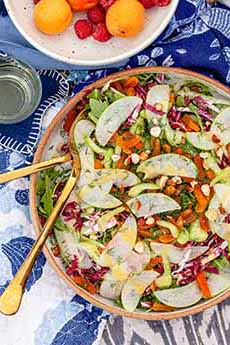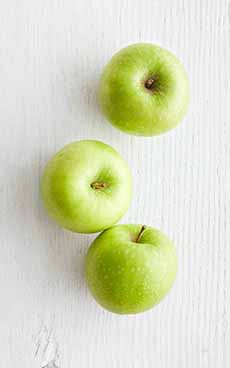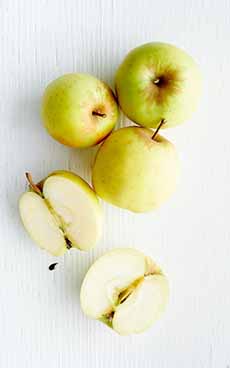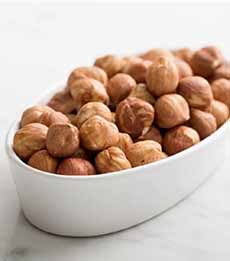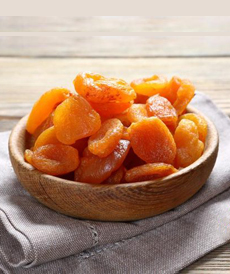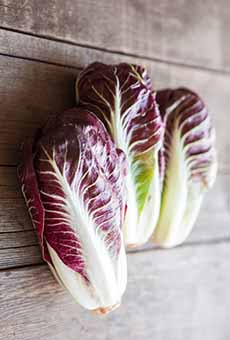Apple Salad With Toasted Hazelnuts Recipe For National Apple Month
|
We can never get enough of a good apple salad. The recipes are crunchy, sweet-tart, and very much seasonal in the fall through the winter months. Red radicchio and orange apricots add fall colors to the mix. We have a collection of apple salad recipes below, and our featured recipe follows the next section. > Thanks to Colavita for the recipe. It’s right below, but first: While some apples are ready to harvest in mid-August through late September or October (Empire Gala, Honeycrisp), others are picked later, in September through November (Cortland, Empire, Gala, Jonagold, Jonathan, Red Delicious). These are the so-called fall apples, which are good storage apples. That’s why apples are still available months later, until the next fall harvest. Still other apples, known as winter apples, are the best for long-term storage (Black Twig, Fuji, Granny Smith, Ida Red, Melrose, Mutsu, Stayman Winesap, Turkey Winesap). Their harvest begins in late September through early October and lasts through November. Apple trivia: There’s a third category of apples, called summer apples, mostly picked from mid to late July. Some must be refrigerated (Earligold, Hawaii, Rambo) and others (Akane, Mollie’s Delicious) can exist on the counter for a brief time. You’re not likely to find summer apples in your supermarket—they don’t travel well. But should you be traveling through apple-growing areas, see if you can find them at farm stands. > The history of apples. While they seem to be ubiquitous, Granny Smith apples (photo #2) have a good substitute: the Mutsu, also known as Crispin* apples (photo #3). A super-tart green apple is similar to Granny Smith apples. Its crisp texture and tangy flavor make it the best choice for salads and slaws. You can also substitute Honeycrisps which are as sweet as Granny Smiths are tart. 1. ROAST (TOAST) the hazelnuts using your preferred method. On the stovetop: Place the nuts/seeds/spices in a heavy, dry skillet over moderate heat, stirring, until fragrant and a shade or two darker, 3 to 5 minutes. Don’t crowd the nuts; use a larger skillet as needed, or toast in two batches. In the oven: Preheat the oven to 350°F and place the nuts/seeds/spices in an ungreased shallow baking pan or a rimmed baking sheet, in a single layer. Roast until golden, 5 to 10 minutes, shaking the pan once or twice for even toasting. In the microwave: For smaller amounts—tablespoon to a 1/2 cup, spread evenly in a single layer on a flat, microwave-safe dish. Add a small amount of softened butter or oil—1/2 teaspoon of fat per 1/2 cup of nuts/seeds/spices. Stir to coat with the fat and microwave on high for 1 minute. Stir and microwave for another minute. If not done to your satisfaction, continue to cook 30 seconds at a time, stirring after each addition of time. 2. MAKE the dressing: Place all the dressing ingredients in a bowl and whisk to combine. You may need to whisk again before drizzling over the salad to make sure the oils and vinegars are well combined (emulsified). They will separate if left alone for too long. 3. ASSEMBLE the salad. Place the radicchio, arugula, celery, apples, apricots, and dill in a large salad bowl. Sprinkle with salt and pepper. 4. DRIZZLE the dressing over the salad and toss to combine. Taste and adjust seasoning. 5. SPRINKLE the chopped hazelnuts over the top and serve. *The Mutsu apple (photo #3) was created in Japan, named after the Mutsu province in which it was bred. It’s a cross between a Golden Delicious and an Indo apple, a very sweet cultivar developed in 1930. Mutsu apples are a popular dessert variety in Japan and are known as the “million-dollar apple.” They are often called Crispin apples in the U.S. and the U.K. In 1968, a marketing campaign chose a more “familiar” name to appeal to consumers. Some U.S. growers prefer to call the apples by their original name, Mutsu [source]. |
|
|
|
CHECK OUT WHAT’S HAPPENING ON OUR HOME PAGE, THENIBBLE.COM.
|
||
